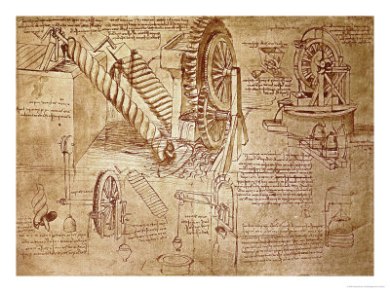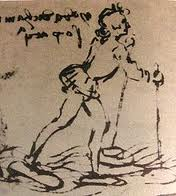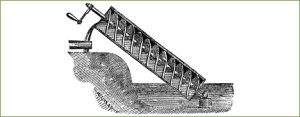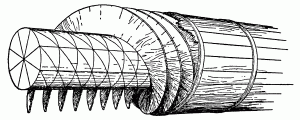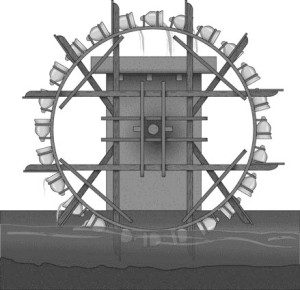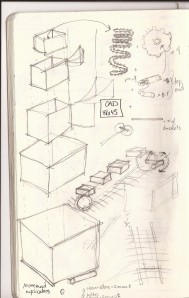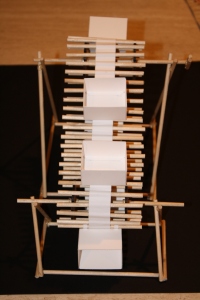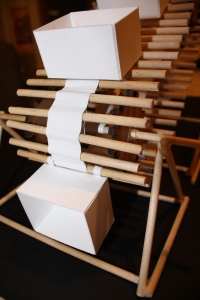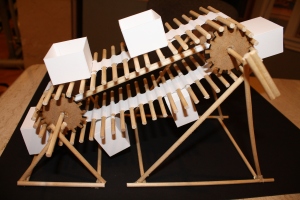In this third phase of projects, I have decided to explore and research Leonardo da Vinci’s machines and inventions. His varied personal explorations can be classified under the four elements: air, earth, fire and water. Water was perhaps the most interesting of the subjects, since Leonardo both admired and feared this element, he called it the “driver of nature”. If water was humanly controlled, then it became the most valuable natural resource. However, if left unattended, water could be the most powerful destructive force found in nature.
Da Vinci was interested in exploring the potential water offered in producing power from its movement and interested in the problem of swimmers, but these questions also brought to his attention more sinister thoughts. As mentionned previously, he knew of water’s destructive capabilities and became obsessed with this fact. He had actually predicted a sort of “end of the world” in terms of a massive flooding that would destroy the entire world and had drawn some sketches of this prediction. This idea drove him to find ingenious solutions for aiding cities as well as people in case this actually happened. Also, Leonardo was developping these ideas during a time of war and had thought of several devices that could be useful to the military.These included the breathing tube, the webbed gloves and the floating device.
He also invented a device for walking on water to allow anyone to escape in case of a flood. The set of instruments was comprised of two poles that were to be used to propel oneself on the surface of the water as well as two large “shoes” that would allow the person to float.
As DaVinci was often inspired by nature for his designs, he also looked into science for informing his decision. The device for walking on water needed consider the Archimedes principle called buoyancy to ensure that one could float on water. He also looked into the Archimedes screw when he was designing machines for moving water to feed aqueducts for example.
Before DaVinci, Vitruvius also studied the Archimedes screw as a machine to move water and he developped his own machines for moving water. In his tenth book on architecture he explains principles governing machines and devotes more than a chapter to water. A large part of what he studied and machines he describes are related to the circular movement of parts working together. He obviously looked to the heavens for inspiration and guidance. As the movement of the stars was considered to be ruled by the gods, then these rules had to be followed or mimicked for the design of any machine on earth in order for these devices to be of any validity.
Vitruvius describes in detail a water wheel onto which buckets are attached. The motion of the water running below the wheel activates the machine and as the wheel is turning the buckets fill with water one by one and are carried around the wheel. When they reach the top, they spill into a container nearby and this allows for water to be raised from a river to a different level, depending on the diameter of the wheel. In his book, he also clearly describes how to construct an Archimedes screw.
My interest in water devices was also fueled by the fact that I realized that even today, we still do not have adequate buildings or devices to help us when floods afflict certain areas of civilization. After several failed attempts at building my own Archimedes screw for bringing water from one level to another, I designed a different device incorporating many of the concepts elaborated by both Vitruvius and DaVinci. I was inspired by the idea of a conveyor system found in the Archimedes screw where a surface continuously pushes the water upwards and also by the idea of having containers to prevent the loss or leakage of water through the device. I wanted to develop a machine to evacuate water that could be readily available to anyone, portable and did not need any kind of power in case of flooding and power outage. My intention was to create a device that could be dismantled and assembled in small simple pieces. All the necessary pieces would fit into one box, so the machine could be easily stored or even transported. People could use this device to evacuate water from a flooded basement for example by setting it up to lift water from that lower level, through a window and out to the ground level.
SOURCES
COOPER, Margaret. The Inventions of Leonardo da Vinci. New York : The MacMillan Company, 1965.
GIBBS-SMITH, Charles and REES, Gareth. The Inventions of Leonardo da Vinci. Oxford : Phaidon, 1978.
VITRUVIUS. (Translated by Morris Hickey Morgan) The Ten Books on Architecture. New York : Dover Publications, Inc. ,1960.
Image sources
Figure 1 – COOPER, Margaret. The Inventions of Leonardo da Vinci. New York : The MacMillan Company, 1965, p. 162.
Figure 2 – GIBBS-SMITH, Charles and REES, Gareth. The Inventions of Leonardo da Vinci. Oxford : Phaidon, 1978, p. 70.
Figure 3 – www.ecogeek.org/component/content/article/2262
Figure 4 – VITRUVIUS. (Translated by Morris Hickey Morgan) The Ten Books on Architecture. New York : Dover Publications, Inc. ,1960, p.295.
Figure 5 – VITRUVIUS. (Translated by Morris Hickey Morgan) The Ten Books on Architecture. New York : Dover Publications, Inc. ,1960, p.296.
Figure 6 & 7 – http://www.machinerylubrication.com/Read/1294/Noria-history
